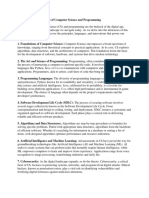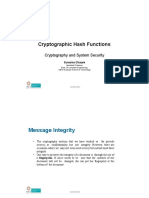0% found this document useful (0 votes)
36 views8 pagesNew Text Document
The document provides an overview of key concepts in Artificial Intelligence (AI) and Machine Learning (ML), including their types and applications. It also discusses advanced cybersecurity concepts, web development basics, and emerging technologies like blockchain and the Internet of Things (IoT). Additionally, it covers fundamental topics in computer science such as programming, data structures, algorithms, and cloud computing.
Uploaded by
siyak7056Copyright
© © All Rights Reserved
We take content rights seriously. If you suspect this is your content, claim it here.
Available Formats
Download as TXT, PDF, TXT or read online on Scribd
0% found this document useful (0 votes)
36 views8 pagesNew Text Document
The document provides an overview of key concepts in Artificial Intelligence (AI) and Machine Learning (ML), including their types and applications. It also discusses advanced cybersecurity concepts, web development basics, and emerging technologies like blockchain and the Internet of Things (IoT). Additionally, it covers fundamental topics in computer science such as programming, data structures, algorithms, and cloud computing.
Uploaded by
siyak7056Copyright
© © All Rights Reserved
We take content rights seriously. If you suspect this is your content, claim it here.
Available Formats
Download as TXT, PDF, TXT or read online on Scribd
/ 8





























































































